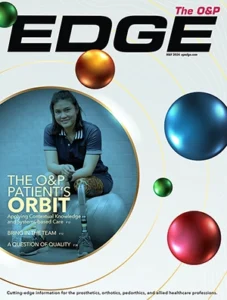Prosthetic sockets trap body heat, and as the temperature builds, the residual limb can sweat, causing skin rashes, blistering, and general discomfort. A team of Wright State University (Wright State), Dayton, Ohio, student researchers is determined to fix that. The students are working on a new prosthetic socket design they plan to present to officials at the Dayton VA Medical Center (VAMC), which has 500 hospital beds and provides a full range of healthcare to veterans.
“We have a pretty decent population in this region that is using this facility to get sockets,” said Tarun Goswami, PhD, joint associate professor of biomedical engineering and orthopaedic surgery at Wright State. “Our job is to try to solve one of their problems: make a more durable design and at the same time take away the sweat and temperature increase.”
Goswami’s student researchers investigated the issue in part by speaking to a few veterans with amputations at the Dayton VAMC. The contacts occurred as the students shadowed Tim Shafer, CPO.
“When talking to the patients, there were some expectations that they really wanted us to focus on,” said Wright State student researcher Paige King. “A lot of it had to do with temperature control. Whenever they were really active, they would experience a lot of moisture that would build up in the liner.”
King said patients also wanted improvements in the skinning-rubbing edges of the socket and possibly a self-adjusting feature to minimize visits to the hospital for refittings. One patient asked for a single socket that could accommodate different attachments to help him pursue his active lifestyle.
Goswami and his researchers also met at the Dayton VAMC with Tim Gasson, chief of prosthetic service; Nick McCray, administrative officer for research and development; and a prosthetics manufacturer to deliver a progress report and brainstorm ideas.
Student Sarah Caup said the research team is looking at developing a liner out of Gore-Tex material that would allow water vapor to escape and not return. She said another approach is making the socket out of innovative materials such as elastin-like protein polymers.
“Elastin is found in your skin, so it’s something that’s very bio-compatible,” she said. “And the tensile strength of the silk is very strong.”
Another possibility, said student Chris Ferguson, is a liner with an air-permeable sleeve and a vacuum pump as well as sensors that would monitor the condition of the residual limb. Ferguson said the researchers also tested a battery-powered plate that could be installed in the socket to reduce the temperature.
Goswami suggested that the students also look into designing a socket that would make contact with the skin only at certain points, creating cooling pockets of air.
The researchers said they may create a design that incorporates a number of the temperature-control ideas and other improvements. They hope to file for patents and produce a prototype that can be tested.




